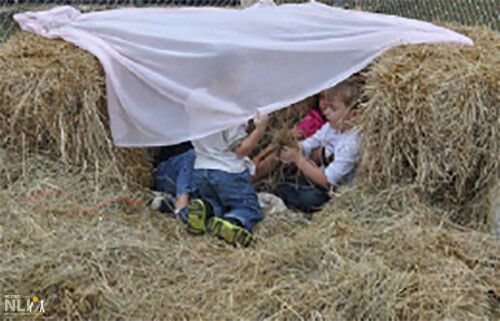The Farm
Creative arts such as drama and pretend play allow for creative and imaginative expression. The creative arts engage children’s minds, bodies, and senses. Creative play activities invite children to listen, observe, discuss, move, solve problems, and imagine using multiple modes of thought and self-expression. Dramatic and artistic play provides ways for young children to learn and use skills in other domains such as language and cognitive development.
Setting:
Designated outdoor play space with sign/label “ THE FARM”
Focus:
Recognizing & Naming Farm Animals
Curricular Areas:
- Creative arts: drama and pretend play
- Language development: receptive and expressive language
- Cognitive development: conceptual knowledge of the natural and physical world
- Fine and gross motor development
- Beginning literacy
Suggestions:
- Attach coat hooks along two interior sides of the barn placed at a height appropriate for children to hang costumes and face/head masks.
- On the back wall, provide several full-length mirrors either attached to the wall or free-standing mirrors similar to those used in the indoor classroom.
- Encourage children to use costumes or face/head masks to look at their new image in the mirror, and act out their animal.
- For twos and older children, call attention to the label name of the animal they select.
- Encourage children to use riding/rocking horses and other manufactured toys to engage in dramatic play.
- Place animal books on bookshelf each day. Encourage children to use animal books and find and match their animal to one of the books.
- Guide children in their play, providing just the right amount of support. For example, teachers can (Davidson 1996):
- Model how to use a prop for pretend play
- Model how to pretend through words and actions
- Model the type of conversation that takes place in the (barnyard) setting
- Make comments that help children notice what each other is doing
- Assume a role and join in to show children that pretend play is important and to introduce new ideas they might want to use in their play
- Intervene in disagreements when necessary to prevent physical harm, to encourage turn-taking, and to encourage sharing
- Increase children’s vocabulary by sharing the names of everything in the play space (path, barn, door, latch, animals, sounds of animals, hook, hang, mirror, costume, mask, hay, pretend, etc.).
- Take photos of children wearing their animal costumes and display in the indoor classroom.
- Encourage children to return costumes and masks to the appropriate hook when they have completed their play with their particular animal.
- Encourage recall indoors by asking children, “What animal were you today? What does that animal say?”
Engaging Parents:
- Take pictures of the children playing on the farm. Post the pictures in a readily-accessible place and/or include them in a parent newsletter.
- Encourage parents to ask and listen to children talk about their farm experience.
Potential Materials/Design Options:
- A designated outdoor play space labeled THE FARM. The area can be designated as a specific play space by bordering the area with low shrubs, hay bales, landscape logs, or a low split rail fence
- A small barn/shed similar to a playhouse in size, with a barn door fastened by a latch
- A defined path from the primary wheel toy track to the barn door or farm area
- Low trough attached to the outside of the barn
- Coat hooks on wall inside the barn at height appropriate for children.
- Full length mirrors
- Costumes and face/head masks of animals
- Labels with large sized letters over each hook with the names of different animals
- Large pictures of animals over each hook
- Several rocking horses outside barn (rocking horses can be stored inside barn overnight or bad weather days) or animal heads on a riding stick
- Small bookshelf with books of animals (both can be stored inside the barn on shelf built over coat hooks and labels)
- Two or three small low stumps for children to sit while using books
- Small bench for teachers to read animal books to children
- Child-sized wheel barrows, shovels, buckets for imaginative play


